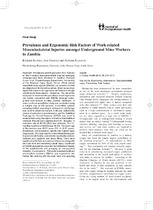| dc.contributor.author | Kunda, Richard | |
| dc.contributor.author | Frantz, Jose M. | |
| dc.contributor.author | Karachi, Farhana | |
| dc.date.accessioned | 2014-08-21T12:15:32Z | |
| dc.date.available | 2014-08-21T12:15:32Z | |
| dc.date.issued | 2013 | |
| dc.identifier.citation | Kunda, R., Frantz, J., & Karachi, F. (2013). Prevalence and ergonomic risk factors of work-related musculoskeletal injuries amongst underground mine workers in Zambia. Journal of Occupational Health, 55: 211–217 | en_US |
| dc.identifier.issn | 1341-9145 | |
| dc.identifier.uri | http://hdl.handle.net/10566/1194 | |
| dc.description.abstract | Work-related musculoskeletal injuries (WMSIs) are common in both developed and third world countries. Most researchers agree that exposure to ergonomic risk factors is a major contributor to these injuries. Objective: The aim of this study was to determine the prevalence of and ergonomic risk factors associated with WMSIs amongst underground mine workers in Kitwe, Zambia. Methods: A cross-sectional quantitative study was conducted using a sample size of 500 workers. A stratified random sampling method according to mining work activity type was used to obtain the sample. Data was collected by means of a structured questionnaire, and the Statistical Package for Social Sciences (SPSS) was used to analyze data using descriptive and inferential statistical methods. Results were significant at 5%. Results: A response rate of 40.4% (202) was obtained. The 12-month prevalence of WMSIs was 42.6%. The mean age of the workers was 40.31 years (SD +/− 8.57 years). Electricians and mechanics reported the highest injury frequencies. The back was the most affected body part. Ergonomic risk factors consistently reported by workers included poor postures and heavy lifting. There were significant (p=0.020) associations between working with the back bent and sustaining a back injury. Significant (p=0.049) associations were also found between injuries of the wrists/hands and grasping an unsupported object(s). Conclusions: This study revealed significant associations between WMSIs and ergonomic risk factors like working with the back bent and grasping object. | en_US |
| dc.language.iso | en | en_US |
| dc.publisher | Japan Society for Occupational Health | en_US |
| dc.rights | © 2013 Kunda, Frantz & Karachi; licensee Health and Medical Publishing Group. This is an Open Access article distributed under the terms of the Creative Commons Attribution License (http://creativecommons.org/licenses/by/3.0), which permits unrestricted use, distribution, and reproduction in any medium, provided the original work is properly cited. | |
| dc.subject | Ergonomics | en_US |
| dc.subject | Mine workers | en_US |
| dc.subject | Musculoskeletal injury | en_US |
| dc.subject | Prevalence | en_US |
| dc.subject | Risk factors | en_US |
| dc.title | Prevalence and ergonomic risk factors of work-related musculoskeletal injuries amongst underground mine workers in Zambia | en_US |
| dc.type | Article | en_US |
| dc.privacy.showsubmitter | false | |
| dc.status.ispeerreviewed | true | |
| dc.description.accreditation | Web of Science | en_US |

